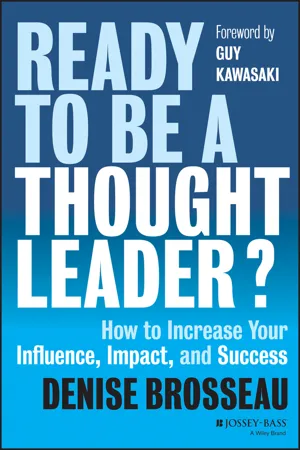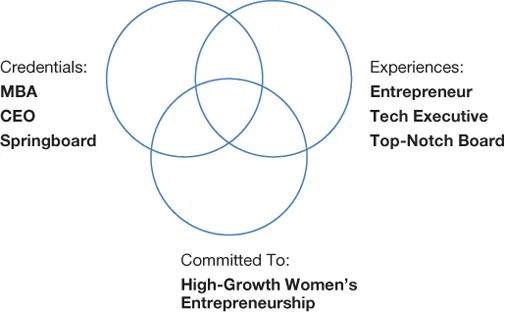![]()
CHAPTER 1
Find Your Driving Passion
I am fortunate to have a wonderful mentor, Intrigue Expert and author Sam Horn. She has taught me a lot about the world of thought leadership and urged me to “Find your uniqueness and exploit it in the service of others.” We both believe that everyone has a right and a responsibility to be one of a kind. But how do you determine that you are one of a kind? How do you find your uniqueness? The first step is to define your niche.
In this chapter we'll cover how to narrow your focus and identify the one or two arenas where you are (or can be) a credible thought leader. Then we'll explore what future you'd like to bring about and what trends you will align to that will ensure your success. We'll also talk about the importance of passion—building your thought leadership in an arena that you care deeply about, one where you are committed to making a difference.
Why is a niche important? Think about the thought leaders we all admire—former president Jimmy Carter, for example. Broadly defined, his post-presidency niche is working for global peace. For U2's lead singer, Bono, his niche is activism for Africa. Oprah is perhaps best known for her efforts in educating girls. Now I'm not suggesting that any of us will ever be a former president, win twenty-two Grammys, or be a globally recognized television personality (or maybe you will!). But we can take some direction from these examples.
Align your time, energy, and resources around one niche and you'll open far more doors than if you focus in multiple unrelated arenas. You'll have far greater impact and influence and gather much greater attention to your topic, idea, or cause if you don't try to “own” more than one niche. Since few of us have the kind of resources of Carter, Bono, or Oprah, it's all the more imperative that we don't fragment our efforts. Focus your talents in one or only a few arenas; you'll have the chance to make a real difference. (And once you have a well-established platform in one area, it's much easier to broaden to another rather than trying to tackle two at the same time.)
So how do you choose? How do you clarify and crystallize your niche?
Do you already have this figured out? Skip ahead to the section on your What If? future. If there is no one obvious arena, topic, or community that you (and others) can call yours, then the next section is for you.
Find Your Niche
If you have worked in one field for a long time, your niche may already be fairly well established—particularly if you have built a distinguished track record or created a body of work in one arena. But if you've never really thought of your career from the perspective of thought leadership (or if you recently entered or want to enter a new arena), I invite you to use the following exercise to identify your niche.
If you are working with a group of people to develop a thought leadership strategy for your company or your cause, this exercise may serve you better if you broaden the questions and include a wider group rather than just completing it yourself.
Can You Pen Your Venn?
Think back to school when you learned about Venn diagrams. Remember those? Three circles overlying each other with an area in the middle where they all three overlap? In this exercise, the three circles are (1) your expertise or experiences, (2) your credentials, and (3) what you're committed to. The central, overlapping area is what I call your “thought leadership intersection point”—your niche. This intersection point will be an arena that can be uniquely yours, or where you'll be one of the few.
I'll use myself as an example so I can show you what I mean. In 1999, I became one of three or four people in the United States who were established thought leaders in the world of high-growth women's entrepreneurship. (For those who are not familiar with the term high-growth in this context, it refers to companies that are funded by equity financing, often angel investment or venture capital, thus allowing the company to grow quickly, often much more quickly than any other type of corporate structure.) I was the CEO of the Forum for Women Entrepreneurs, an organization I had cofounded six years earlier to help women-founded and women-led companies build the knowledge, connections, and gain access to the resources they needed so they could raise equity financing for their companies.
Thus, what I was committed to was high-growth women's entrepreneurship—or getting more women entrepreneurs funded. My credentials, which helped people believe me to be credible as a thought leader, were that I had an MBA from Stanford; I was the CEO of an organization with a track record of serving women entrepreneurs; and I had cofounded Springboard, the first venture conference for women entrepreneurs. I also had had the experience of starting and running a successful business when I was twenty-six; I had worked as a technology executive at several Fortune 500 companies; and I had built a top-notch board for my organization.
My Venn diagram then looked like this:
I can't pretend that I understood all this back then. It was the outside world that defined my niche for me—particularly the press when they called me as a subject-matter expert on the dot-com boom and women entrepreneurs. I was then able to build on that credibility as I began to develop my own point of view about how the future should unfold and what changes were needed so that more women entrepreneurs could get funded. But that's jumping ahead; let's focus on you now.
How to Pen Your Venn
Ready to create your own Venn diagram? Get out a copy of your resume or bio, a highlighter, and some paper and begin to answer the following questions. Create as complete a list as you can and don't hesitate to use multiple pages.
Step 1: What Are Your Credentials?
Depending on your career choices, you may have gained your credentials by the letters after your name, by what jobs you've held, what licenses or certificates you've completed, or what status you've achieved in your organization. That said, I use the term credentials broadly—it doesn't imply only people with a formal education. I have met amazing thought leaders without a high school diploma. Here are a few things to think about as you complete this exercise.
As an executive, your credentials are often denoted by job title or rank, by the teams you've led or been a part of, the deals you've closed, the products you've shipped, or the services you've developed. If you've worked at Fortune 500 companies, that can add a certain amount of credibility as well.
As an entrepreneur, your credentials are most often tied to the revenue, brand, or popularity of your company or products. They can also be tied to the amount of money you raised or a successful exit you helped achieve. Serial entrepreneurs, even when they have had one spectacular failure, have stronger credentials than first-time CEOs.
As a community or nonprofit leader, your credentials include your title or rank, the size and reputation of your organization, and the type of challenge that you are tackling, as well as the impact you and your organization have had in that arena.
As a service provider, in addition to any professional certifications you've received, your credentials are defined by your title and rank but also by the size and reputation of your organization and that of your clients.
As an academic, in addition to your degrees, the reputation of your institution and your own rank within that institution are often your strongest credentials.
No matter which career choice you've made, other ways you may have established your credentials are by materials you've written (articles, white papers, books, blogs, research papers), awards or honors you've received, or other associations that you've affiliated with or where you have taken a leadership role.
Think objectively and imagine what others who know you well might say about you. Jot down everything that comes to mind. Don't limit yourself to work arenas. Add any leadership roles you've held, even as a volunteer.
Step 2: What Is Your Expertise or Unique Experience?
Next start a new page and write down your areas of expertise and your unique experiences. Again we are not thinking narrowly here. What skills do you have; what events have you lived through; what talents have you developed? Have you had a unique experience—a transformative experience—that set you on a new path? What is one topic around which you are the guru? Have you invented anything or been the first to accomplish something? Are you more knowledgeable than 95 percent of the world about something? Have you survived or overcome something and then learned some lessons?
Where have you lived or traveled? Anywhere unusual? Have you completed significant research in an arena or figured out how to do something that others don't know how to do? Have you started a company or organization, led a merger, built a product, managed an initiative? Are you a great public speaker or storyteller, a renowned expert in cheese, or in command of more hockey statistics than anyone who ever lived? Write it down! What do others call you about to get your advice or counsel? What are you the known (or budding) expert in? What makes you stand out from the crowd? If you want more questions to spark your thinking, see “More Food for Thought” at the end of the chapter.
Step 3: What Are You Committed to or Passionate About?
Before we jump into this next part of the exercise, I want to set the stage by sharing a quote with you from the first female chief of the Cherokee Nation, Wilma Mankiller: “The happiest people I've ever met, regardless of their profession, their social standing, or their economic status, are people that are fully engaged in the world around them. The most fulfilled people are the ones who get up every morning and stand for something larger than themselves. They are the people who care about others, who will extend a helping hand to someone in need or will speak up about an injustice when they see it.”1 I couldn't have said it better myself.
What do you stand for? Take a new piece of paper and write down the things that you're passionate about and committed to. Where do you devote your time, even when no one is willing to pay you? What group of people do you stand for and with? What can you speak about at length if someone gives you an opening? What is the one problem that you want to help solve, one situation that is occurring that you'd like to see halted, or one arena where new possibilities are opening up that you'd like to be the first to understand? Where do you disagree with the accepted point of view? Where do you see a new way of doing things that others don't yet see? How would you like to transform people's way of thinking?
What would others say you're committed to that you haven't included? In the last three months, what have you spent your spare time doing? What topics do you find yourself drawn to when you're standing in the library, selecting a TV show, or reading a magazine? What problems are happening in your industry or in your state that you'd like to have an impact on? Think about challenges or problems you've helped to solve (or want to solve) in your company, region, or school district. What about bigger challenges you've been involved with—political, economic, environmental?
Think broadly; there are no limits here. Make a long list, maybe thirty or forty items. Whatever gets you up in the morning, whatever lights you up and makes you willing to fight for a cause or an issue you believe in, could go on the list. If you want more quest...



